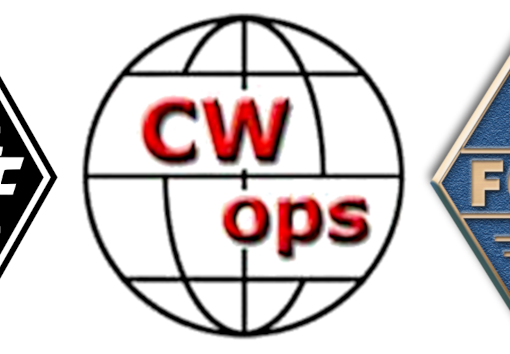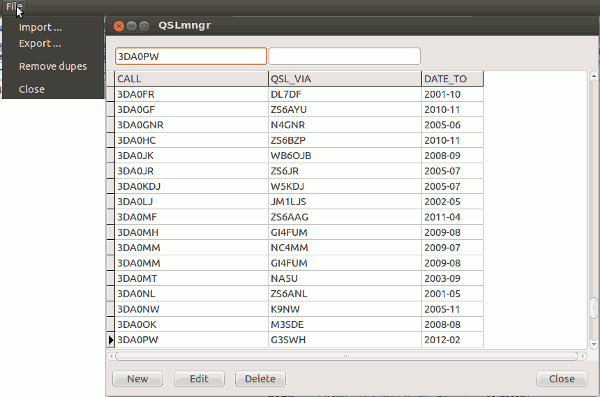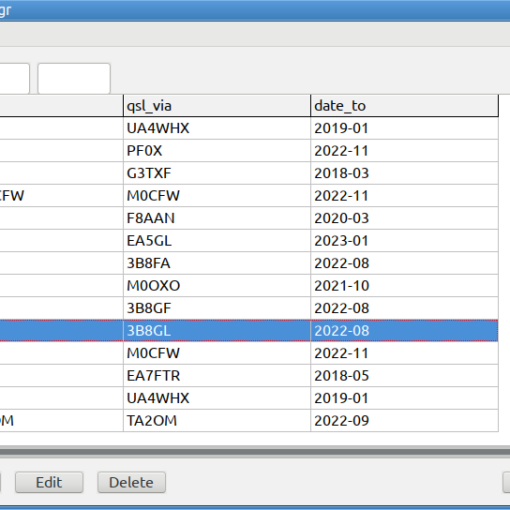TRADIF v. 1.6
Conversion TR Log N6TR files to the ADIF format
This utility converts log files from TR Log to the ADIF format and is independent of the contest type. It may also be used to convert logs created by TR Log in the GENERAL QSO mode when it will correctly pick up and convert any data in the name and the placement of contents of the exchange field so name address fields.
TR Log has no time_off facility. TRADIF assumes that both time_on and time_off are the same.
Options:
F1 – will attempt to convert all of the data in the selected *.dat file to *.adi. In any cases where some data is not correctly converted using F1 (eg. SPDX) F2 or F3 should be selected. Using F1 with GENERAL *.dat files will correctly convert both NAME and QTH (but be sure that the name you enter is not greater than 11 characters).
F4 – will import data up to RST Rcvd field and permit you to write the rest of the data into selected ADIF column. You should select the proper position of the exchange to be converted and desired ADIF column. TRADIF provides a possibility to convert two different parts of exchange into two different ADIF columns.
F5 – same as F4 but with possibility to add your own com- ment to be pasted into selected column. EXAMPLE: You are processing your log of the FOC Marathon where the part of exchange is the FOC Membership number. You want to put the FOC number into the “Comments” column but with an indica- tion what the number means. This option allows to insert the “FOC#” addition to the “Comments” column. It will result in “FOC# 1234” in the “Comments” column.
F6 – quit the program.
How to select the position:
You may find a small dial like this:
|.....................|
5 6 7 7
45678901234567890123456
ADIF Column selection
| Select | ADIF ID | Type | Description |
| [a] | AGE | N | Age of other station operator |
| [b] | ARRL_SECT | C | ARRL Section |
| [c] | CNTY | C | US County in the format STATE, COUNTY. For example GA,BARROW. Use CQ County list |
| [d] | COMMENT | C | Comment field for QSO |
| [e] | CONT | C | Continent: NA, SA, EU, AF, OC, AS |
| [f] | CONTEST_ID | C | Contest Indentifier – CQWW, etc. |
| [g] | CQZ | N | CQ Zone |
| [h] | DXCC | N | Numeric identifiers from ARRL. |
| [i] | GRIDSQUARE | C | 4, 6, 8 or however many characters |
| [j] | IOTA | C | HYPHEN MUST BE INCLUDED. Example: NA-001 (IOTA PROVIDES DISK IN THIS FORMAT) |
| [k] | ITUZ | N | ITU Zone |
| [l] | NAME | C | Name of other station operator |
| [m] | NOTES | M | Long text for digital copy, third party traffic, etc. |
| [n] | PFX | C | WPX prefix |
| [o] | PROP_MODE | C | Propagation mode (Aurora, MS etc.) |
| [p] | QSLMSG | M | Personal message to appear on QSL card |
| [q] | QSL_VIA | C | QSL route of other station |
| [r] | QTH | C | QTH of other station |
| [s] | RX_PWR | N | Power of other station in Watts |
| [t] | SAT_MODE | C | Satellite Mode |
| [u] | SAT_NAME | C | Satellite name |
| [v] | SRX | N | Received serial number for a contest QSO |
| [w] | STATE | C | US state |
| [x] | TEN_TEN | N | Ten-Ten number |
| [y] | VE_PROV | C | Canadian province, 2-letter abbreviations: AB, BC, MB, NB, NF, NS, NT, ON, PE, QC, SK, YT |
Quick mode:
Operation:
Disclaimer:
This version is meant as final and is no competitor to the LOGCONV utility by Robert Barron, KA5WSS, which is contest dependent but may process contest files much better. If you missed some feature in TRADIF, look first at LOGCONV (then you should ask for addition…).
License:
If you like this software, and feel so inclined, send a donation to your local Animal Shelter. A dollar or two here and there can frequently make a big difference. It may be enough to keep a dog or cat alive for one more day, perhaps the day that someone will come to adopt them. The Animal Shelters do a great job most of the time, but they can’t be expected to keep animals indefinitely until some- one wants them. They live by the same rules that we do, where the “Almighty Dollar” is in command. If a few of us send them a little bit, maybe it will do some good.
I love animals, and they are frequently more at the mercy of our society than any people are. If a person doesn’t like his position, he is free to do something about it. Jobs can be found, professions are a little harder, but jobs CAN be found. The domesticated animals don’t have that luxury. They are subject to our rules, and in many cases our rules don’t fit them that well. When they are hungry and homeless, they get locked up for a few days, but if no one comes for them, their time is up.
Finally, the best thing you may do is to adopt an animal from the Animal Shelter. Give them a bit of your love and you’ll see better things than our favorite – ham radio.
A small donation, postcard or e-mail welcome any time if you meet TRADIF useful. Donations will be redirected immediately to the Animal Shelter.
Praha, Feb. 13, 2000 Martin, OK1RR



